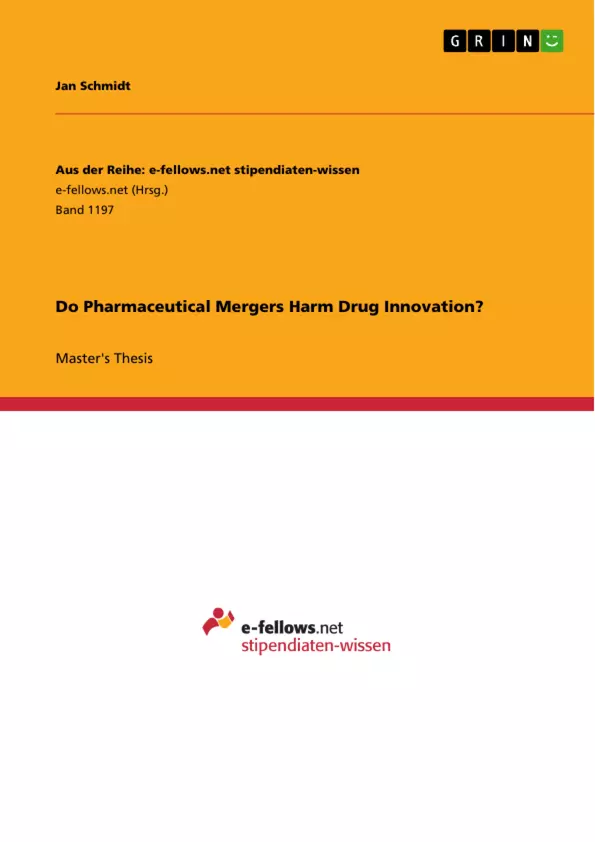The number and volume of pharmaceutical companies’ mergers and acquisitions have reached exorbitant magnitudes in the last decade, with estimations of over 1,300 deals worth US$ 690 billion between 2000 and 2009.1 The biggest transaction, valued at US$ 66.7 billion2, occurred in 2009 when Pfizer bought Wyeth. The sheer dimension of transactions in this sector, being subject to significant public interest, poses questions about the motivations behind these deals, which are mostly believed to be countermeasures for patent expirations, as well as the impact on drug innovation.
Even though, the regular object of interest regarding mergers is the shareholder value, in this specific case drug innovation is of particular interest as it does not only influence the future prospects of the pharmaceutical companies but also long term public health. Hence, the objective of this thesis is to discover what the impact of pharmaceutical mergers on R&D intensity and efficiency of the acquiring organization and on the pharmaceutical industry as a whole is.
Inhaltsverzeichnis (Table of Contents)
- 1. INTRODUCTION
- 2. THEORETICAL FRAMEWORK AND INDUSTRY
- 2.1. OVERVIEW OF M&A THEORY AND THE PHARMACEUTICAL INDUSTRY
- 2.2. REVIEW OF R&D AND THE DRUG APPROVAL PROCESS
- 3. EMPIRICAL ANALYSES
- 3.1. EMPIRICAL SPECIFICATION AND DATA
- 3.1.1. EMPIRICAL SPECIFICATION
- 3.1.2. DATA
- 3.2. RESULTS - MERGERS & ACQUISITIONS AND R&D INTENSITY
- 3.3. MERGERS & ACQUISITIONS AND R&D EFFICIENCY
- 3.1. EMPIRICAL SPECIFICATION AND DATA
- 4. SMALL ACQUISITIONS AND THEIR IMPACT ON INDUSTRY EFFICIENCY
- 5. DISCUSSION, LIMITATIONS AND FOOD FOR THOUGHT
Zielsetzung und Themenschwerpunkte (Objectives and Key Themes)
This thesis aims to examine the impact of pharmaceutical mergers on the Research and Development (R&D) intensity and efficiency of acquiring organizations and the pharmaceutical industry as a whole. It explores the motivations behind mergers and acquisitions in the pharmaceutical sector, particularly in relation to patent expirations and their potential impact on drug innovation.
- Motivations for pharmaceutical mergers and acquisitions.
- The impact of mergers on R&D intensity and efficiency.
- The role of small acquisitions in fostering innovation.
- The drug approval process and its impact on R&D.
- Policy implications for the pharmaceutical industry.
Zusammenfassung der Kapitel (Chapter Summaries)
- Chapter 1: Introduction: This chapter provides a background on the increasing number and value of pharmaceutical mergers and acquisitions, highlighting the notable transaction between Pfizer and Wyeth in 2009. It emphasizes the significance of understanding the impact of these mergers on drug innovation, which is crucial for both pharmaceutical companies and public health. The thesis aims to investigate the relationship between mergers and R&D intensity and efficiency.
- Chapter 2: Theoretical Framework and Industry: This chapter offers an overview of general M&A theory, exploring the motivations for mergers and acquisitions in the pharmaceutical industry specifically. It examines the main findings of existing research, highlighting the importance of understanding the factors that drive mergers, including economies of scale, scope, growth opportunities, and market power. The chapter further delves into the nature of R&D in the pharmaceutical sector, including regulations and processes related to drug approval and patenting.
- Chapter 3: Empirical Analyses: This chapter presents an empirical analysis of the relationship between mergers and acquisitions and R&D intensity and efficiency. It examines data on major pharmaceutical companies, focusing on their R&D spending and its correlation with mergers. The analysis considers the impact of M&A on R&D efficiency by relating spending to patent applications, controlling for genuine innovations and remakes. The chapter explores the effects of mergers on both R&D intensity and efficiency.
- Chapter 4: Small Acquisitions and Their Impact on Industry Efficiency: This chapter delves into the qualitative aspects of small acquisitions. It discusses the research efficiency of smaller and medium-sized companies, examining their impact on the industry's development efficiency. The chapter explores how major pharmaceutical players often acquire startups or innovative research companies to refresh their patent portfolios and secure promising intellectual property. It analyzes whether these deals contribute to overall drug innovation efficiency by allowing smaller, potentially more efficient companies to benefit from a sell-off opportunity.
Schlüsselwörter (Keywords)
This thesis focuses on the interplay between pharmaceutical mergers and acquisitions, drug innovation, research and development (R&D) intensity and efficiency, patent expirations, drug approval process, and policy implications. The research investigates the impact of mergers on the pharmaceutical industry's innovative capacity and explores the role of smaller acquisitions in fostering innovation. It emphasizes the importance of understanding the economic and societal consequences of M&A activity in the pharmaceutical sector.
- Citation du texte
- Jan Schmidt (Auteur), 2013, Do Pharmaceutical Mergers Harm Drug Innovation?, Munich, GRIN Verlag, https://www.grin.com/document/299729



